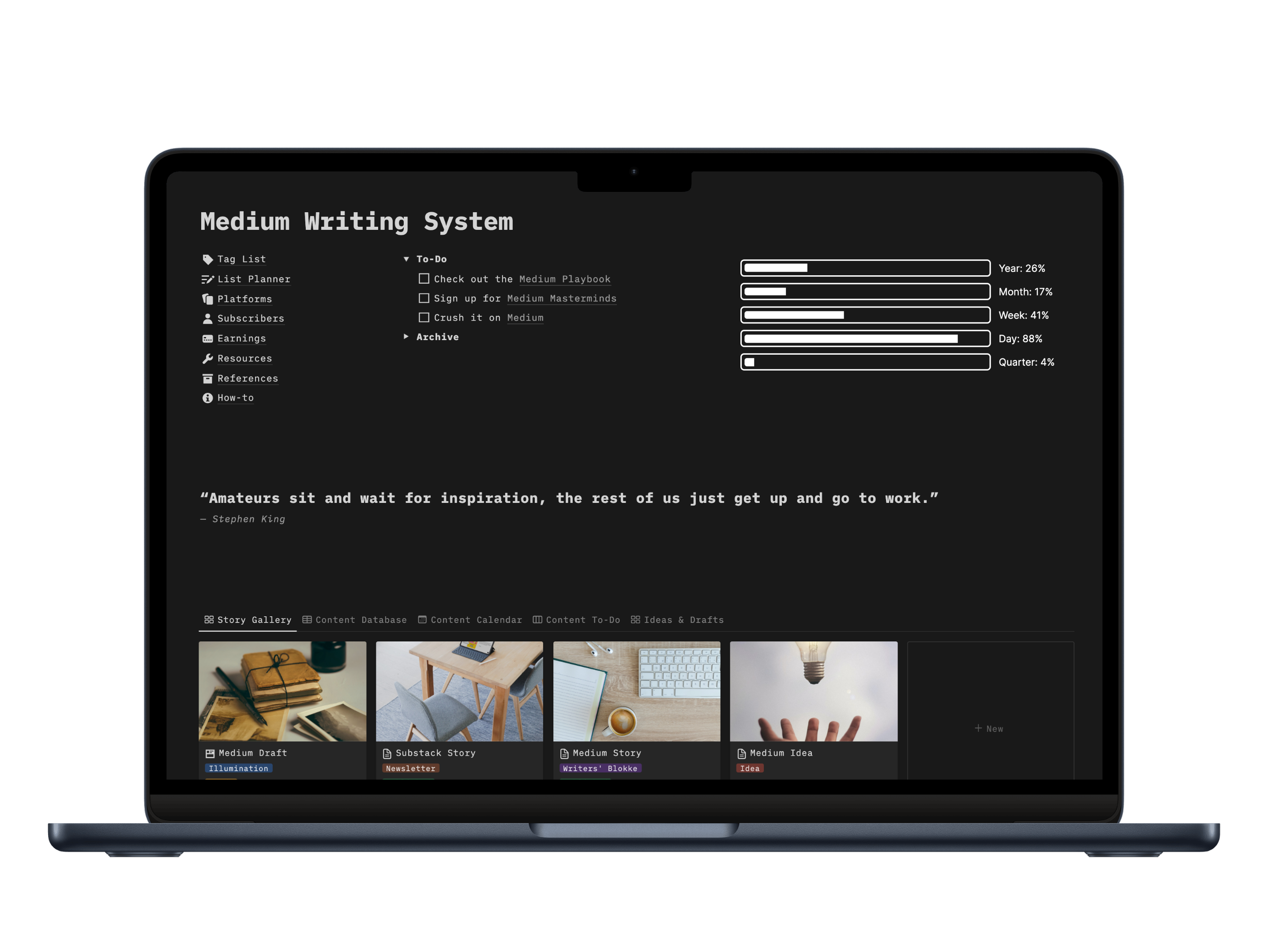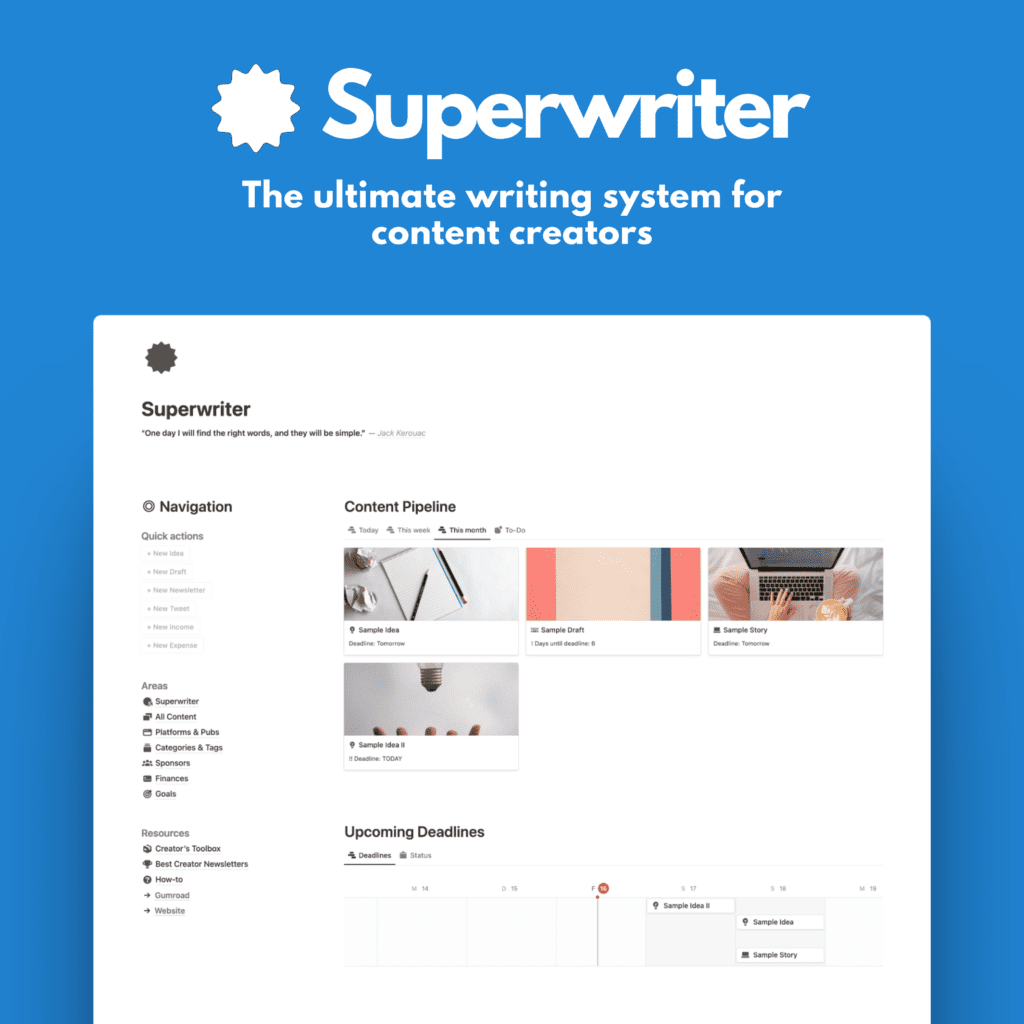If you want to elevate your writing and take it to new heights, it’s crucial to have effective management and planning systems in place.
One tool that has revolutionized the way many writers organize their content is Notion. Notion is an all-in-one productivity tool that combines the functionalities of note-taking and reminder apps, a writing tool, a project management platform, and a robust database architecture.
With features like formulas, relations, and roll-ups, Notion is a productivity beast that can help streamline your writing process. Best of all, it’s free to use!
My Notion journey
As an avid user of Notion for the past two years, I have discovered its immense potential for managing my personal notes, running my faceless YouTube channels, and even organizing my Medium content.
In this article, I will walk you through how I utilize Notion to write, plan, and maintain my Medium posts. By the end, I’ll share a Notion template with you to get started!
Working with Notion
For those unfamiliar with Notion, it is an all-in-one workplace that seamlessly integrates various functions into a single platform.
Whether you need a place to jot down notes, set reminders, manage projects, or build complex databases, Notion has got you covered.
Its robust database architecture empowers you with powerful features such as formulas, relations, and roll-ups, making it incredibly versatile and adaptable to your specific needs.
Notion can be as simple or as complex as you want it to be. Some prefer a blank page, others a myriad of interconnected databases with tags, formulas, and relations. Whatever floats your boat.
Creating a database for your writing
To effectively manage your Medium posts and other written content, I recommend setting up a dedicated content database in Notion.
I personally created this database to house all my written work, including my Medium posts and other outlets I contribute to like Substack, Vocal, NewsBreak, my blog, and even social media or YouTube scripts. It’s all in one database, connected and filtered.
While the focus of my database is Medium-centric, you can adapt it to suit your preferred platforms and categories.
To create your writing database, simply open a new Notion page and click on the “+” sign next to the cursor and look for Table View, or type “/inlinetable” to initiate the process. Once created, your database becomes a centralized hub for all your written content, allowing you to access and organize your posts effortlessly.

If that sounds too complicated to you, you’ll find my ready-to-use template on Gumroad. More about that in a minute.
Structuring your content database
When setting up your content database, it’s essential to define the key information you want to track for each post.
Start with the most fundamental element, the name of the post, which will serve as the title for each entry. Clicking on the name will open up the respective page with the full text body and all relevant information.
To provide a comprehensive overview of your posts, create additional columns for important data points.
Some columns that I find essential for managing Medium content are :
- Status: Idea, draft, submitted, published, etc.
- Publishing date
- Tags: Medium topics or other tags
- Platform: where you published the post(s)
- Link/URL

Medium-relevant columns for enhanced organization
To cater to my Medium-centric content, I incorporated specific columns that further streamline the management process.
The first of these columns is the Republished Story or platform column, which allows me to keep track of other platforms I use to cross-post my stories.
Notion’s tag selection property enables me to choose from a predefined set of tags or create new ones on the fly.
By utilizing the multi-select property for Platforms and Tags, I can assign multiple entries to a single post, such as Medium, Simily, or NewsBreak as platform, and various tags for each story, enhancing the flexibility of the database.
Another essential column is the Status column, which indicates the current state of each post. With the multi-select property, I can assign labels like Published, Submitted, Draft, or Idea to keep track of the progress of each piece. These categories align well with Medium’s structure and provide a clear overview of the development stage of each post. Of course, these can be anything you want. Additional status options might be helpful for other platforms.
Columns worth considering for Medium include Publication, where you can note the specific publication on Medium and a section dedicated to Medium Lists, where you can list all the curated lists your stories belongs to.
Two additional columns that may appear simple at first glance but offer significant value are the Curated and Viralcolumns.
These columns feature checkboxes that can be marked to indicate whether a Medium story of yours has been curated or has gone viral. While seemingly basic, these checkboxes can be utilized in powerful ways.
By filtering for Curated or Viral entries in the future, you can gain valuable insights into patterns related to topic selection, chosen publications, added tags, and more. Data points that may help you identify why posts do well or not.
These checkboxes provide a visual representation of the relation between the posts that have gone viral and those that have been curated, helping you identify common factors that contribute to their success.
Making the most of your Notion database
While the aforementioned elements provide a solid foundation for managing your Medium content, there is much more you can do with Notion to optimize your workflow and enhance your writing process.

Here are a few additional database views and features that I find particularly beneficial:
- The Planner View: In addition to the main view, I recommend creating a Content Calendar view. This view displays a calendar with your published posts, providing a visual representation of your achievements and allowing you to plan future posts effectively. Seeing a month filled with stories offers a sense of accomplishment and serves as a constant reminder of your progress. Also you can drag-and-drop everything easily here.
- The Pretty View: Another view that I find visually appealing is the Content Gallery. This secondary view sports a card layout with the featured image of each post showcased prominently. The Content Gallery offers an aesthetically pleasing way to browse through your posts, making it easier to find specific content or gain inspiration for future projects.
- The Task View: To manage your drafts and ideas effectively, consider creating a Content To-Do view using the Kanban board style. This view presents all your drafts and ideas as cards that can be dragged and dropped between different stages, such as from the idea stage to the draft stage. This visual representation allows you to track the progress of your writing and prioritize your tasks accordingly.
The Top Writer Tag database
In addition to the content database, I have also found great value in maintaining a separate but connected database for Medium Top Writer Tags.

This database contains a complete list of top writer tags, along with competition rates based on the number of stories written for each tag and the number of Medium writers associated with them.
This Top Writer Tag list serves multiple purposes:
- Tracking achievements: You can easily check off the tags you have achieved on Medium, providing a sense of accomplishment and progress in your writing journey.
- Identifying opportunities: By sorting tags based on their competition rates, ranging from very low to very high, you can identify tags that are less competitive and potentially easier to obtain. This enables you to strategically choose tags that may enhance your visibility and reach.
- Streamlining tag selection: For every new story you write, consulting the Top Writer Tag list allows you to quickly identify suitable tags that align with your content. This saves time and ensures that you optimize your tag selection for maximum exposure.
Taking control of your writing journey with Notion
As you transition from a casual writer to a (semi-)professional blogger who publishes multiple stories per week, effective management, structure, and organization of your content become paramount.
Notion and my writing system provide the perfect solution to achieve this, offering powerful integration of multiple tools and workflows that empower you to write, plan, and archive your work seamlessly.
Not only does Notion centralize your writing process, but its powerful search functionality also allows you to locate specific details about individual posts or perform extensive analysis across multiple entries. The convenience of filtering specific aspects of your content grants you deep insights into your progress and areas for improvement, all within a few clicks.
Notion becomes a valuable partner in your writing journey, streamlining your workflow and helping you achieve your writing goals.
Get started with Notion & Medium
To assist you in getting started with Notion for managing your writing, I have created a Notion template specifically tailored for Medium content.
This system called the “Medium Writing System” includes the structure and features discussed here, providing you with a solid foundation to build upon.

You can access the template and duplicate it to your Notion workspace to make any necessary adjustments and customize it according to your preferences.
The Medium Writing System included the described content database and the Top Writer Tag list, as well as other helpful connected databases like subscribers, affiliates or partners, earnings, and more.
To access the Medium Writing System, visit my Gumroad store. And with this link, you’ll get 30% off the price today as well!
The bottom line
With its versatile features, seamless integration, and user-friendly interface, Notion is an invaluable tool for Medium writers seeking to enhance their productivity and organization.
By adopting Notion as your go-to platform for managing your writing, you can streamline your workflow, gain valuable insights, and take your Medium stories and earnings to new heights.
Get started with my provided system, customize it to your needs, and rock Medium 2023!








